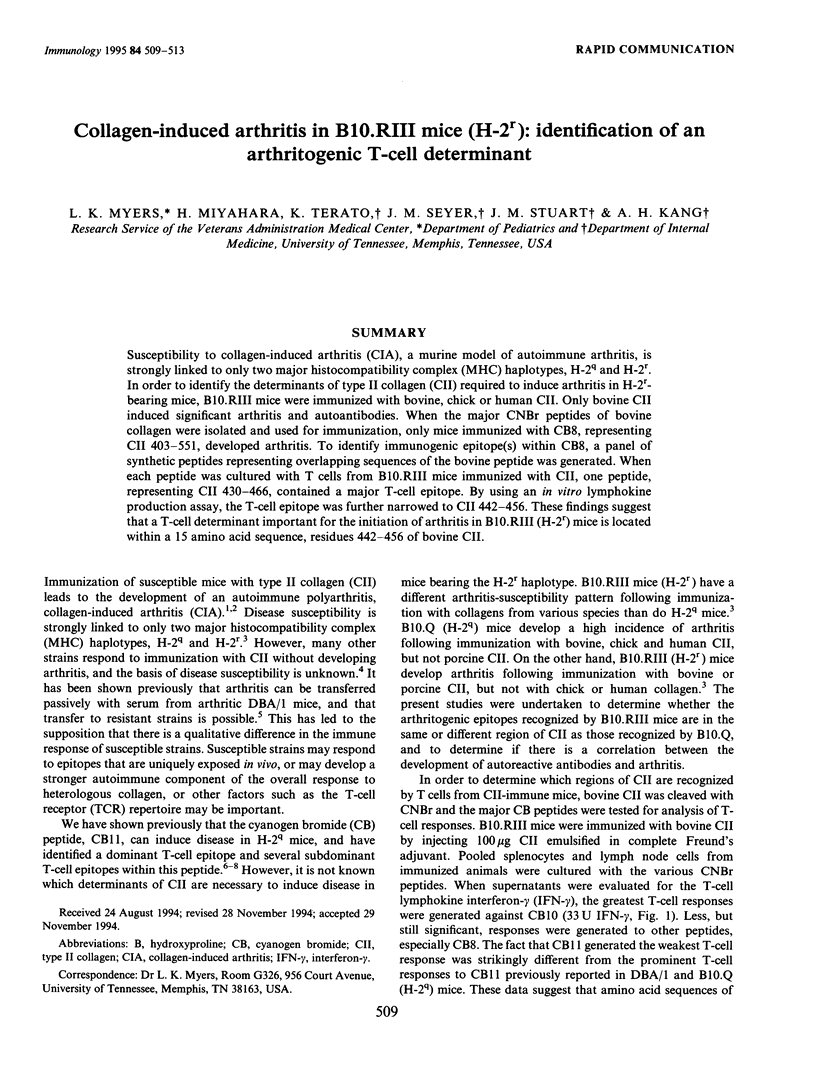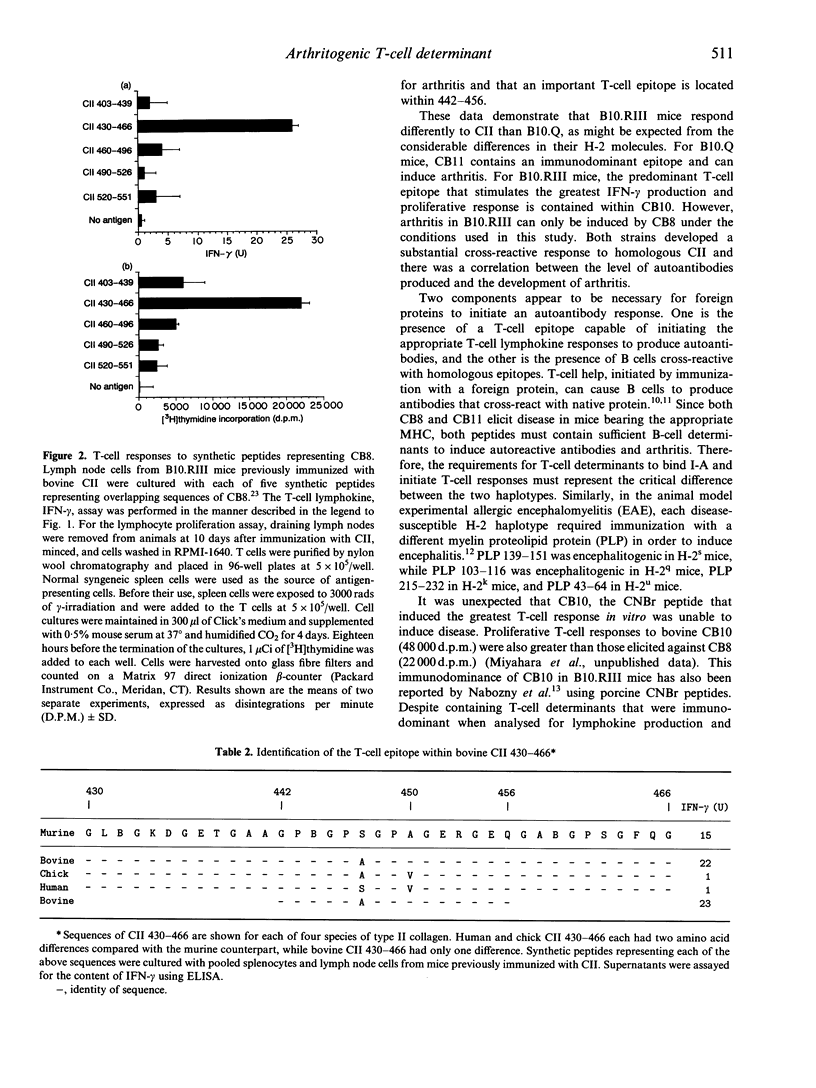Abstract
Susceptibility to collagen-induced arthritis (CIA), a murine model of autoimmune arthritis, is strongly linked to only two major histocompatibility complex (MHC) haplotypes, H-2q and H-2r. In order to identify the determinants of type II collagen (CII) required to induce arthritis in H-2r-bearing mice, B10.RIII mice were immunized with bovine, chick or human CII. Only bovine CII induced significant arthritis and autoantibodies. When the major CNBr peptides of bovine collagen were isolated and used for immunization, only mice immunized with CB8, representing CII 403-551, developed arthritis. To identify immunogenic epitope(s) within CB8, a panel of synthetic peptides representing overlapping sequences of the bovine peptide was generated. When each peptide was cultured with T cells from B10.RIII mice immunized with CII, one peptide, representing CII 430-466, contained a major T-cell epitope. By using an in vitro lymphokine production assay, the T-cell epitope was further narrowed to CII 442-456. These findings suggest that a T-cell determinant important for the initiation of arthritis in B10.RIII (H-2r) mice is located within a 15 amino acid sequence, residues 442-456 of bovine CII.
Full text
PDF




Selected References
These references are in PubMed. This may not be the complete list of references from this article.
- Brand D. D., Myers L. K., Terato K., Whittington K. B., Stuart J. M., Kang A. H., Rosloniec E. F. Characterization of the T cell determinants in the induction of autoimmune arthritis by bovine alpha 1(II)-CB11 in H-2q mice. J Immunol. 1994 Mar 15;152(6):3088–3097. [PubMed] [Google Scholar]
- Butler W. T., Miller E. J., Finch J. E., Jr, Inagami T. Homologous regions of collagen alpha1(I) and alpha1(II) chains: apparent clustering of variable and invariant amino acid residues. Biochem Biophys Res Commun. 1974 Mar 15;57(1):190–195. doi: 10.1016/s0006-291x(74)80375-x. [DOI] [PubMed] [Google Scholar]
- Courtenay J. S., Dallman M. J., Dayan A. D., Martin A., Mosedale B. Immunisation against heterologous type II collagen induces arthritis in mice. Nature. 1980 Feb 14;283(5748):666–668. doi: 10.1038/283666a0. [DOI] [PubMed] [Google Scholar]
- Gautam A. M., Pearson C. I., Smilek D. E., Steinman L., McDevitt H. O. A polyalanine peptide with only five native myelin basic protein residues induces autoimmune encephalomyelitis. J Exp Med. 1992 Aug 1;176(2):605–609. doi: 10.1084/jem.176.2.605. [DOI] [PMC free article] [PubMed] [Google Scholar]
- Greer J. M., Kuchroo V. K., Sobel R. A., Lees M. B. Identification and characterization of a second encephalitogenic determinant of myelin proteolipid protein (residues 178-191) for SJL mice. J Immunol. 1992 Aug 1;149(3):783–788. [PubMed] [Google Scholar]
- Konomi H., Seyer J. M., Ninomiya Y., Olsen B. R. Peptide-specific antibodies identify the alpha 2 chain as the proteoglycan subunit of type IX collagen. J Biol Chem. 1986 May 25;261(15):6742–6746. [PubMed] [Google Scholar]
- Mamula M. J., Lin R. H., Janeway C. A., Jr, Hardin J. A. Breaking T cell tolerance with foreign and self co-immunogens. A study of autoimmune B and T cell epitopes of cytochrome c. J Immunol. 1992 Aug 1;149(3):789–795. [PubMed] [Google Scholar]
- Mamula M. J. The inability to process a self-peptide allows autoreactive T cells to escape tolerance. J Exp Med. 1993 Feb 1;177(2):567–571. doi: 10.1084/jem.177.2.567. [DOI] [PMC free article] [PubMed] [Google Scholar]
- Miller E. J. Isolation and characterization of the cyanogen bromide peptides from the l(II) chain of chick cartilage collagen. Biochemistry. 1971 Aug 3;10(16):3030–3035. doi: 10.1021/bi00792a007. [DOI] [PubMed] [Google Scholar]
- Moudgil K. D., Sercarz E. E. Dominant determinants in hen eggwhite lysozyme correspond to the cryptic determinants within its self-homologue, mouse lysozyme: implications in shaping of the T cell repertoire and autoimmunity. J Exp Med. 1993 Dec 1;178(6):2131–2138. doi: 10.1084/jem.178.6.2131. [DOI] [PMC free article] [PubMed] [Google Scholar]
- Myers L. K., Seyer J. M., Stuart J. M., Terato K., David C. S., Kang A. H. T cell epitopes of type II collagen that regulate murine collagen-induced arthritis. J Immunol. 1993 Jul 1;151(1):500–505. [PubMed] [Google Scholar]
- Myers L. K., Stuart J. M., Seyer J. M., Kang A. H. Identification of an immunosuppressive epitope of type II collagen that confers protection against collagen-induced arthritis. J Exp Med. 1989 Dec 1;170(6):1999–2010. doi: 10.1084/jem.170.6.1999. [DOI] [PMC free article] [PubMed] [Google Scholar]
- Myers L. K., Terato K., Seyer J. M., Stuart J. M., Kang A. H. Characterization of a tolerogenic T cell epitope of type II collagen and its relevance to collagen-induced arthritis. J Immunol. 1992 Aug 15;149(4):1439–1443. [PubMed] [Google Scholar]
- Stuart J. M., Cremer M. A., Kang A. H., Townes A. S. Collagen-induced arthritis in rats. Evaluation of early immunologic events. Arthritis Rheum. 1979 Dec;22(12):1344–1351. doi: 10.1002/art.1780221205. [DOI] [PubMed] [Google Scholar]
- Stuart J. M., Dixon F. J. Serum transfer of collagen-induced arthritis in mice. J Exp Med. 1983 Aug 1;158(2):378–392. doi: 10.1084/jem.158.2.378. [DOI] [PMC free article] [PubMed] [Google Scholar]
- Suhrbier A., Rodda S. J., Ho P. C., Csurhes P., Dunckley H., Saul A., Geysen H. M., Rzepczyk C. M. Role of single amino acids in the recognition of a T cell epitope. J Immunol. 1991 Oct 15;147(8):2507–2513. [PubMed] [Google Scholar]
- Terato K., Hasty K. A., Cremer M. A., Stuart J. M., Townes A. S., Kang A. H. Collagen-induced arthritis in mice. Localization of an arthritogenic determinant to a fragment of the type II collagen molecule. J Exp Med. 1985 Aug 1;162(2):637–646. doi: 10.1084/jem.162.2.637. [DOI] [PMC free article] [PubMed] [Google Scholar]
- Terato K., Hasty K. A., Reife R. A., Cremer M. A., Kang A. H., Stuart J. M. Induction of arthritis with monoclonal antibodies to collagen. J Immunol. 1992 Apr 1;148(7):2103–2108. [PubMed] [Google Scholar]
- Trentham D. E., Townes A. S., Kang A. H. Autoimmunity to type II collagen an experimental model of arthritis. J Exp Med. 1977 Sep 1;146(3):857–868. doi: 10.1084/jem.146.3.857. [DOI] [PMC free article] [PubMed] [Google Scholar]
- Wooley P. H., Luthra H. S., Griffiths M. M., Stuart J. M., Huse A., David C. S. Type II collagen-induced arthritis in mice. IV. Variations in immunogenetic regulation provide evidence for multiple arthritogenic epitopes on the collagen molecule. J Immunol. 1985 Oct;135(4):2443–2451. [PubMed] [Google Scholar]
- Wooley P. H., Luthra H. S., Stuart J. M., David C. S. Type II collagen-induced arthritis in mice. I. Major histocompatibility complex (I region) linkage and antibody correlates. J Exp Med. 1981 Sep 1;154(3):688–700. doi: 10.1084/jem.154.3.688. [DOI] [PMC free article] [PubMed] [Google Scholar]
- Wraith D. C., Bruun B., Fairchild P. J. Cross-reactive antigen recognition by an encephalitogenic T cell receptor. Implications for T cell biology and autoimmunity. J Immunol. 1992 Dec 1;149(11):3765–3770. [PubMed] [Google Scholar]


